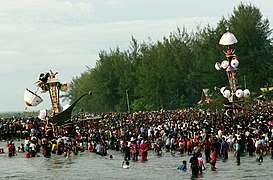Ashura
| Ashura | |
|---|---|
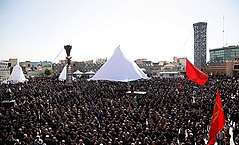 Ashura mourning in Imam Hossein Square, Tehran, 2016 | |
| Official name | عاشوراء ʻĀshūrā’ (in Arabic) |
| Also called | |
| Observed by | Muslims |
| Type | Islamic and national (In some countries such as Afghanistan, Azerbaijan, Bahrain, Iran, Lebanon, Pakistan, Bangladesh, Iraq, and India) |
| Significance | Marks the martyrdom of Husayn ibn Ali according to Shia Islam; the day that Moses fasted as gratitude for the liberation of the Israelites according to Sunni Islam |
| Observances |
Mourn and derive messages from Husayn's sacrifice (Shia Islam) Fasting (Sunni Islam) |
| Date | 10 Muharram |
| 2017 date | October 1[1] |
| 2018 date | September 20[2] |
| 2019 date | September 9[2] |
| 2020 date | August 28[2] |
| Frequency | Annual |
| |
|---|
 |
|
|
Yom Ashura or Ashura (Arabic: عاشوراء ʻĀshūrā’) is the tenth day of Muḥarram, the first month in the Islamic calendar.[3] For the majority of Shia Muslims, as well as some Sunni Muslims, Ashura marks the climax of the Remembrance of Muharram,[3] and commemorates the death of Husayn ibn Ali, the grandson of Prophet Muhammad, at the Battle of Karbala on 10 Muharram in the year 61 AH (in AHt: October 10, 680 CE).[4] Sunni Muslims have the same accounts of these events, but ceremonial mourning did not become a custom - although poems, eulogizing and recounting the events were and continue to be common.[5][6][7] Mourning for the incident began almost immediately after the Battle of Karbala. Popular elegies were written by poets to commemorate the Battle of Karbala during the Umayyad and Abbasid era, and the earliest public mourning rituals occurred in 963 CE during the Buyid dynasty.[8] In Afghanistan,[9] Iran,[10] Iraq,[11] Lebanon,[12] Azerbaijan, Bahrain,[13] Bangladesh [14]and Pakistan,[15] Ashura has become a national holiday, and many ethnic and religious communities participate in it.[16][17]
In Sunni Islam, Ashura also marks the day that Moses and the Israelites were saved from Pharaoh by God creating a path in the Sea, and is the Islamic equivalent to Yom Kippur.[18][19][20][21] Other commemorations include Noah leaving the Ark and Prophet Muhammad's arrival in Medina.[22]
Etymology
The root of the word Ashura has the meaning of tenth in Semitic languages; hence the name of the remembrance, literally translated, means "the tenth day". According to the orientalist A. J. Wensinck, the name is derived from the Hebrew ʿāsōr, with the Aramaic determinative ending.[23] The day is indeed the tenth day of the month, although some Islamic scholars offer up different etymologies. In his book Ghuniyatut Talibin, Sheikh Abdul Qadir Jilani writes that Islamic scholars differ as to why this day is known as Ashura, some of them suggesting that it is the tenth most important day with which God has blessed Muslims.[24]
Historical background
The Battle of Karbala took place within the crisis environment resulting from the succession of Yazid I.[25][26] Immediately after succession, Yazid instructed the governor of Medina to compel Husayn and a few other prominent figures to pledge their allegiance (Bay'ah).[4] Husayn, however, refrained from making such a pledge, believing that Yazid was openly going against the teachings of Islam and changing the sunnah of Prophet Muhammad.[27][28] He, therefore, accompanied by his household, his sons, brothers, and the sons of Hasan left Medina to seek asylum in Mecca.[4]
On the other hand, the people in Kufa, when informed of Muawiyah's death, sent letters urging Husayn to join them and pledging to support him against the Umayyads. Husayn wrote back to them saying that he would send his cousin Muslim ibn Aqeel to report to him on the situation, and that, if he found them supporter as their letters indicated, he would speedily join them because an Imam should act in accordance with the Quran and uphold justice, proclaim the truth, and dedicate himself to the cause of God. The mission of Muslim was initially successful and according to reports, 18,000 men pledged their allegiance. But the situation changed radically when Yazid appointed Ubayd Allah ibn Ziyad as the new governor of Kufa, ordering him to deal severely with Ibn Aqeel. Before news of the adverse turn of events had reached Mecca, Husayn set out for Kufa.[4]
On the way, Husayn found that his messenger, Muslim ibn Aqeel, had been killed in Kufa. Husayn encountered the army of Ubaydullah ibn Ziyad along the route towards Kufa. Husayn addressed the Kufan army, reminding them that they had invited him to come because they were without an Imam. He told them that he intended to proceed to Kufa with their support, but if they were now opposed to his coming, he would return to where he had come from. In response, the army urged him to proceed by another route. Thus, he turned to the left and reached Karbala, where the army forced him not to go further and stop at a location that was without water.[4]

Ubaydullah ibn Ziyad, the governor instructed Umar ibn Sa'ad, the head of the Kufan army, to offer Ḥusayn and his supporters the opportunity to swear allegiance to Yazid. He also ordered Umar ibn Sa'ad to cut off Husayn and his followers from access to the water of the Euphrates.[4] On the next morning, Umar ibn Sa'ad arranged the Kufan army in battle order.[4]
The Battle of Karbala lasted from morning to sunset on October 10, 680 (Muharram 10, 61 AH). Husayn's small group of companions and family members (in total around 72 men and the women and children)[lower-alpha 1][30][31] fought against a large army under the command of Umar ibn Sa'ad and were killed near the river (Euphrates), from which they were not allowed to get water. The renowned historian Abū Rayḥān al-Bīrūnī states:
… [T]hen fire was set to their camp and the bodies were trampled by the hoofs of the horses; nobody in the history of the human kind has seen such atrocities.[32]
Once the Umayyad troops had murdered Husayn and his male followers, they looted the tents, stripped the women of their jewelry, and took the skin upon which Zain al-Abidin was prostrate. Husayn's sister Zaynab was taken along with the enslaved women to the caliph in Damascus when she was imprisoned and after a year eventually was allowed to return to Medina.[33][34]
Commemoration of the death of Husayn ibn Ali
| A series of articles on |
| Husayn ibn Ali |
|---|
 |
| Life |
| Remembrance |
|
| Perspectives |
|
|
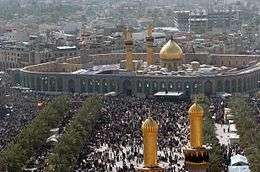
History of the commemoration by Shia
According to Ignác Goldziher,
[E]ver since the black day of Karbala, the history of this family … has been a continuous series of sufferings and persecutions. These are narrated in poetry and prose, in a richly cultivated literature of martyrologies …'More touching than the tears of the Shi'is' has even become an Arabic proverb.[35]
The first assembly (majlis) of the Commemoration of Husayn ibn Ali is said to have been held by Zaynab in prison. In Damascus, too, she is reported to have delivered a poignant oration. The prison sentence ended when Husayn's 3-year-old daughter, Sakina, died in captivity. She would often cry in prison to be allowed to see her father. She is believed to have died when she saw her father's mutilated head. Her death caused an uproar in the city, and Yazid, fearing a potential uprising, freed the captives.[36]
Imam Zayn Al Abidin said the following:
It is said that for twenty years whenever food was placed before him, he would weep. One day a servant said to him, 'O son of Allah's Messenger! Is it not time for your sorrow to come to an end?' He replied, 'Woe upon you! Jacob the prophet had twelve sons, and Allah made one of them disappear. His eyes turned white from constant weeping, his head turned grey out of sorrow, and his back became bent in gloom,[lower-alpha 2] though his son was alive in this world. But I watched while my father, my brother, my uncle, and seventeen members of my family were slaughtered all around me. How should my sorrow come to an end?'[lower-alpha 3][37][38]
Husayn's grave became a pilgrimage site among Shia Muslims only a few years after his death. A tradition quickly developed of pilgrimage to the Imam Husayn Shrine and the other Karbala martyrs, known as Ziarat ashura.[39] The Umayyad and Abbasid caliphs tried to prevent construction of the shrines and discouraged pilgrimage to the sites.[40] The tomb and its annexes were destroyed by the Abbasid caliph Al-Mutawakkil in 850–851 and Shia pilgrimage was prohibited, but shrines in Karbala and Najaf were built by the Buwayhid emir 'Adud al-Daula in 979–80.[41]
Public rites of remembrance for Husayn's martyrdom developed from the early pilgrimages.[42] Under the Buyid dynasty, Mu'izz ad-Dawla officiated at public commemoration of Ashura in Baghdad.[43] These commemorations were also encouraged in Egypt by the Fatimid caliph al-'Aziz.[44] With the recognition of Twelvers as the official religion by the Safavids, Mourning of Muharram extended throughout the first ten days of Muharram.[39]
Azadari (mourning) rituals
The words Azadari (Persian: عزاداری) which mean mourning and lamentation; and Majalis-e Aza have been exclusively used in connection with the remembrance ceremonies for the martyrdom of Imam Hussain. Majalis-e Aza, also known as Aza-e Husayn, includes mourning congregations, lamentations, matam and all such actions which express the emotions of grief and above all, repulsion against what Yazid stood for.[45]
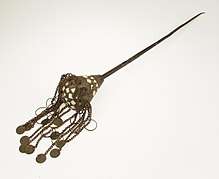
These religious customs show solidarity with Husayn and his family. Through them, people mourn Husayn's death and express regret for the fact that they were not present at the battle to fight and save Husayn and his family.[46][47]
Popular customs
After almost 12 centuries, five types of major rituals were developed around the battle of Karbala. These rituals include the memorial services (majalis al-ta'ziya), the visitation of Husayn's tomb in Karbala particularly on the occasion of the tenth day of Ashura and the fortieth day after the battle (Ziyarat Ashura and ziyarat al-Arba'in), the public mourning processions (al-mawakib al-husayniyya or the representation of the battle of Karbala in the form of a play (the shabih), and the flagellation (tatbir).[48] Some Shia Muslims believe that taking part in Ashura washes away their sins.[49] A popular Shia saying has it that "a single tear shed for Husayn washes away a hundred sins".[50]
For Shia Muslims, the commemoration of Ashura is not a festival but rather a sad event, while Sunni Muslims view it as a victory God gave to Moses. For Shia Muslims, it is a period of intense grief and mourning. Mourners congregate at a mosque for sorrowful, poetic recitations such as marsiya, noha, latmiya, and soaz performed in memory of the martyrdom of Husayn, lamenting and grieving to the tune of beating drums and chants of "Ya Hussain". Also, Ulamas give sermons with themes of Husayn's personality and position in Islam, and the history of his uprising. The Sheikh of the mosque retells the Battle of Karbala to allow his listeners to relive the pain and sorrow endured by Husayn and his family and they read Maqtal Al-Husayn[48][51]. In some places, such as Iran, Iraq, and the Arab states of the Persian Gulf, passion plays known as Ta'zieh [52] are performed, reenacting the Battle of Karbala and the suffering and martyrdom of Husayn at the hands of Yazid.In the Caribbean islands of Trinidad and Tobago and Jamaica Ahsura, known locally as 'Hussay' or Hosay is commemorated for the grandson of Prophet Muhammad, but its celebration has adopted influence from other religions including Roman Catholic, Hindu, and Baptists, making it a mixture of different cultures and religion. The event is attended by both Muslims and non-Muslims depicting an environment of mutual respect and tolerance.[53][54] For the duration of the remembrance, it is customary for mosques and some people to provide free meals (nazri) on certain nights of the month to all people.[55].
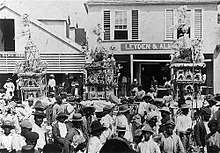
.jpg)
Certain traditional flagellation rituals such as Talwar zani (talwar ka matam or sometimes tatbir) use a sword. Other rituals such as zanjeer zani or zanjeer matam involve the use of a zanjeer (a chain with blades).[56] This is not without controversy however as some Shia clerics have denounced the practice saying "it creates a backward and negative image of their community." Believers are instead encouraged to donate blood to those in need.[57]On Ashura, very few Shia Muslims observe mourning with a blood donation, which is called "Qame Zani", and flailing. This mourning is considered to be a shameless way for most Shia Muslims and most of them are against this kind of mourning.[58]In some areas, such as in the Shia suburb of Beirut, Shia communities organize blood donation drives with organizations like the Red Cross or the Red Crescent on Ashura as a replacement for self-flagellation rituals like tatbir and qame zani.[59]
Significance among religions
Shia Islam
On the 10th of the month of Muharrem – The Ashure Day – Huseyn bin Ali was murdered at Karbala[61] Remembrance by Jafaris, Qizilbash Alevi-Turks, and Bektashis together in Ottoman Empire
This day is of particular significance to Twelver Shia and Alawites, who consider Husayn (the grandson of Prophet Muhammad) Ahl al-Bayt, the third Imam to be the rightful successor of Prophet Muhammad.
.jpg)
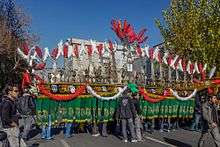
According to Kamran Scot Aghaie, "The symbols and rituals of Ashura have evolved over time and have meant different things to different people. However, at the core of the symbolism of Ashura is the moral dichotomy between worldly injustice and corruption on the one hand and God-centered justice, piety, sacrifice and perseverance on the other. Also, Shiite Muslims consider the remembrance of the tragic events of Ashura to be an important way of worshipping God in a spiritual or mystical way."[62]
Shia Muslims make pilgrimages on Ashura, as they do forty days later on Arba'een, to the Mashhad al-Husayn, the shrine in Karbala, Iraq, that is traditionally held to be Husayn's tomb. On this day Shia is in remembrance, and mourning attire is worn. They refrain from listening to or playing music since Arabic culture generally considers music impolite during death rituals. It is a time for sorrow and for showing respect for the person's passing, and it is also a time for self-reflection when one commits oneself completely to the mourning of Husayn. Shia Muslims do not plan weddings and parties on this date. They mourn by crying and listening to recollections of the tragedy and sermons on how Husayn and his family were martyred. This is intended to connect them with Husayn's suffering and martyrdom, and the sacrifices he made to keep Islam alive. Husayn's martyrdom is widely interpreted by Shia Muslims a symbol of the struggle against injustice, tyranny, and oppression.[63] Shia Muslims believe the Battle of Karbala was between the forces of good and evil, with Husayn representing good and Yazid representing evil.[64]
Shia Imams strongly insist that the day of Ashura should not be celebrated as a day of joy and festivity. The day of Ashura, according to Eighth Shia Imam Ali al-Rida, must be observed as a day of rest, sorrow, and total disregard of worldly matters.[65]
Some of the events associated with Ashura are held in special congregation halls known as "Imambargah" and Hussainia.[66]
Sunni Islam
Sunnis regard fasting during Ashura as recommended, though not obligatory, having been superseded by the Ramadan fast. Sahih Muslim, (Hadith-2499)[67] According to hadith record in Sahih Bukhari, Ashura was already known as a commemorative day during which some Makkah residents used to observe customary fasting. Prophet Muhammad fasted on the day of Ashura, 10th Muharram, in Makkah. When fasting during the month of Ramadan became obligatory, the fast of Ashura was made non-compulsory.[18][19]
Judaism
According to Muslim tradition, the Jews also fasted on the tenth day. According to Sunni Muslim tradition, Ibn Abbas narrates that Prophet Muhammad came to Medina and saw the Jews fasting on the tenth day of Muharram. He asked, "What is this?" They said, "This is a good day, this is the day when Allah saved the Children of Israel from their enemy and Musa (Moses) fasted on this day." He said, "We have more claim over Musa than you." So he fasted on the day and told the people to fast.[18][19][68][69] This tenth in question is believed to be the tenth of the Jewish month of Tishri, which is Yom Kippur in Judaism.[70] The Torah designates the tenth day of the seventh month as holy and a fast (Lev. 16, Lev. 23, Num. 29). The word "tenth" in Hebrew is Asarah or Asharah (עשרה), which is from the same Semitic root A-SH-R. According to this tradition, Prophet Muhammad continued to observe the veneration of Ashura modeled on its Jewish prototype in late September until shortly before his death, which the verse of Nasi' was revealed and the Jewish-type calendar adjustments of the Muslims became prohibited. From then on, Ashura became distinct from its Jewish predecessor of Yom Kippur.[71]

Socio-political aspects
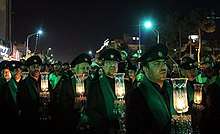
Commemoration of Ashura has great socio-political value for the Shia, who have been a minority throughout their history. According to the prevailing conditions at the time of the commemoration, such reminiscences may become a framework for implicit dissent or explicit protest. It was, for instance, used during the Islamic Revolution of Iran, the Lebanese Civil War, the Lebanese resistance against the Israeli military presence and in the 1990s Uprising in Bahrain. Sometimes the Ashura commemorations associate the memory of Al-Husayn's martyrdom with the conditions of Islam and Muslims in reference to Husayn's famous quote on the day of Ashura: "Every day is Ashura, every land is Karbala".[72]
From the period of the Iranian Constitutional Revolution (1905–1911) onward, mourning gatherings increasingly assumed a political aspect. Following an old established tradition, preachers compared the oppressors of the time with Imam Husayn's enemies, the umayyads.[73]
The political function of commemoration was very marked in the years leading up to the Islamic Revolution of 1978–79, as well as during the revolution itself. In addition, the implicit self-identification of the Muslim revolutionaries with Imam Husayn led to a blossoming of the cult of the martyr, expressed most vividly, perhaps, in the vast cemetery of Behesht-e Zahra, to the south of Tehran, where the martyrs of the revolution and the war against Iraq are buried.[73]
On the other hand, some governments have banned this commemoration. In the 1930s Reza Shah forbade it in Iran. The regime of Saddam Hussein saw this as a potential threat and banned Ashura commemorations for many years.[74] In the 1884 Hosay massacre, 22 people were killed in Trinidad and Tobago when civilians attempted to carry out the Ashura rites, locally known as Hosay, in defiance of the British colonial authorities.[75]
Violence during Ashura
Terrorist attacks against Shia Muslims have occurred in several countries, on the day of Ashurra.[76] The repeated experience of violence at Ashura has produced an "interesting" feedback effect in Shia history.[77]
- 1994 – explosion of a bomb at the Imam Reza shrine, June 20, in Mashhad, Iran, 20 people killed[78]
- 2004 – bomb attacks, during Shia pilgrimage to Karbala, March 2, Karbala, Iraq, 178 people killed and 5000 injured[79]
- 2008 – clashes, between Iraqi troops and members of a Shia cult, January 19, Basra and Nasiriya, Iraq, 263 people killed[80]
- 2009 – explosion of a bomb, during the Ashura procession, December 28, Karachi, Pakistan, dozens of people killed and hundreds injured[81]
- 2010 – detention of 200 Shia Muslims, at a shop house in Sri Gombak known as Hauzah Imam Ali ar-Ridha (Hauzah ArRidha), December 15, Selangor[82]
- 2011 – explosion of a bomb, during the Ashura procession, December 28, Hilla and Baghdad, Iraq, December 5, 30 people killed[83]
- 2011 – suicide attack, during the Ashura procession, Kabul, Afghanistan, December 6, 63 people killed[84]
- 2015 – three explosions, during the Ashura procession, mosque in Dhaka, Bangladesh, October 24, one person killed and 80 people injured[85]
In the Gregorian calendar
While Ashura is always on the same day of the Islamic calendar, the date on the Gregorian calendar varies from year to year due to differences between the two calendars, since the Islamic calendar is a lunar calendar and the Gregorian calendar is a solar calendar. Furthermore, the appearance of the crescent moon that is used to determine when each Islamic month begins varies from country to country due to the different geographic locations.
| AH | Gregorian date |
|---|---|
| 1438 | 2016, October 12 (Middle East: Lebanon, Iraq, Iran) |
| 1439 | 2017, October 1 (Middle East: Lebanon, Iraq, Iran)[86] |
| 1440 | 2018, September 20 |
| 1441 | 2019, September 9 |
See also
Notes
- ↑ Except his young son, Ali, who was severely ill during that battle.[29]
- ↑ Quran, 12:84
- ↑ From Shaykh as-Sadooq, al-Khisal; quoted in al-Ameen, A’yan, IV, 195. The same is quoted from Bin Shahraashoob's Manaqib in Bih’ar al-Anwar, XLVI, 108; Cf. similar accounts, Ibid, pp. 108–10
Citations
- ↑ "Holidays in Iran in 2017".
- 1 2 3 "When is Ashura Day Worldwide".
- 1 2 "Shiite History Beliefs and Differences Berween Sunnis and Shiites: Muslim Sects and Sunnis". Archived from the original on February 2, 2015. Retrieved January 26, 2015.
- 1 2 3 4 5 6 7 Madelung, Wilferd. "Ḥisayn B. ʿAli i. Life and Significance in Shiʿism". Encyclopædia Iranica Online. Retrieved November 4, 2014.
- ↑ "My Ashura, My Karbala, My Hussein: A Sunni perspective http://www.huffingtonpost.com/sadok-benabdallah/my-ashura-my-karbala-my-h_b_12517900.html Retrieved February 10, 2017
- ↑ Fundamentalisms and the state: remaking polities, economies, and militance Martin Marty, R. Appleby. University of Chicago Press. 1996 p. 451
- ↑ Religion, social practice, and contested hegemonies reconstructing the public sphere in Muslim majority societies Armando Salvatore, Mark LeVine. Palgrave Macmillan. 2005 p. 93
- ↑ Cornell, Vincent J.; Kamran Scot Aghaie (2007). Voices of Islam. Westport, CN: Praeger Publishers. pp. 117–18. ISBN 978-0275987329. Retrieved November 4, 2014.
- ↑ "Public Holidays in Afghanistan". worldtravelguide.net. Retrieved October 10, 2015.
- ↑ "Public Holidays in Iran". worldtravelguide.net. Retrieved October 10, 2015.
- ↑ "Public Holidays in Iraq". worldtravelguide.net. Retrieved October 10, 2015.
- ↑ "Public Holidays in Lebanon". worldtravelguide.net. Retrieved October 10, 2015.
- ↑ "Public Holidays in Bahrain". worldtravelguide.net. Retrieved October 10, 2015.
- ↑ Staff, Writer. "Ashura in India". timeanddate.
- ↑ "Public Holidays in Pakistan". worldtravelguide.net. Retrieved October 10, 2015.
- ↑ "AhlulBayt News Agenc en". May 9, 2016.
- ↑ "Hindus holding tasia procession in Orissa for over three centuries - Jafariya News Network".
- 1 2 3 Sahih Bukhari Book 31 Hadith 222, Book 55 Hadith 609, and Book 58 Hadith 279, ; Sahih Muslim Book 6 Hadith 2518, 2519, 2520
- 1 2 3 Javed Ahmad Ghamidi. Mizan, The Fast Archived September 30, 2007, at the Wayback Machine., Al-Mawrid
- ↑ Morrow, John Andrew. Islamic Images and Ideas: Essays on Sacred Symbolism. McFarland & Co, 2013. pp. 234–36. ISBN 978-0786458486
- ↑ Katz, Marion Holmes The Birth of The Prophet Muhammad: Devotional Piety in Sunni Islam. Routledge, 2007. pp.113–115. ISBN 978-1135983949
- ↑ Abou-Samra, Sulafa (2011). "Muslim Calendar, holy days, and festivals". Islamic Beliefs, Practices, and Cultures. Marshall Cavendish. p. 153. ISBN 978-0761479260.
- ↑ A. J. Wensinck, "Āshūrā", Encyclopaedia of Islam 2. Retrieved June 8, 2011.
- ↑ Staff, Writer. "Top 10 similar words or synonyms for ashura". wordsimilarity.
- ↑ G.R., Hawting (2012). "Yazīd (I) b. Muʿāwiya". Encyclopaedia of Islam (second ed.). Brill.
- ↑ Hitti, Philip K. (1961). The Near East In History A 5000 Year Story. Literary Licensing, LLC. ISBN 1258452456. Retrieved September 23, 2016.
- ↑ "Al Bidayah wa al-Nihayah".
- ↑ "Al-Sawa'iq al-Muhriqah".
- ↑ Hoseini-e Jalali, Mohammad-Reza (1382). Jehad al-Imam al-Sajjad (in Persian). Translated by Musa Danesh. Iran, Mashhad: Razavi, Printing & Publishing Institute. pp. 214–17.
- ↑ "در روز عاشورا چند نفر شهید شدند؟". Archived from the original on March 26, 2013.
- ↑ "فهرست اسامي شهداي كربلا". Velaiat.com. Archived from the original on June 29, 2012. Retrieved June 30, 2012.
- ↑ Chelkowski, Peter J. (1979). Ta'ziyeh: Ritual and Drama in Iran. New York. p. 2.
- ↑ Madelung, Wilferd. "ʿALĪ B. ḤOSAYN B. ʿALĪ B. ABĪ ṬĀLEB". ENCYCLOPÆDIA IRANICA. Retrieved August 1, 2011.
- ↑ Donaldson, Dwight M. (1933). The Shi'ite Religion: A History of Islam in Persia and Irak. Burleigh Press. pp. 101–11.
- ↑ Goldziher, Ignác (1981). Introduction to Islamic Theology and Law. Princeton. p. 179.
- ↑ "Zaynab Bint Ali". Encyclopedia of Religion. Retrieved January 19, 2008.
- ↑ Sharif al-Qarashi, Bāqir (2000). The Life of Imām Zayn al-Abidin (as). Translated by Jāsim al-Rasheed. Iraq: Ansariyan Publications, n.d. Print.
- ↑ Imam Ali ubnal Husain (2009). Al-Saheefah Al-Sajjadiyyah Al-Kaamelah. Translated with an Introduction and annotation by Willian C. Chittick With a foreword by S. H. M. Jafri. Qum, The Islamic Republic of Iran: Ansariyan Publications.
- 1 2 "Hosayn B. Ali in Popular Shiism". Encyclopedia of Iranica. Archived from the original on January 17, 2008. Retrieved December 16, 2010.
- ↑ al Musawi, 2006, p. 51.
- ↑ Litvak, 1998, p. 16.
- ↑ Nafasul Mahmoom. JAC Developer. pp. 12–. GGKEY:RQAZ12CNGF5.
- ↑ Chelkowski, Peter (January 1, 1985). "Shia Muslim Processional Performances". The Drama Review: TDR. MIT Press. 29 (3): 18–30. doi:10.2307/1145650. JSTOR 1145650.
- ↑ Blank, Jonah. Mullahs on the Mainframe: Islam and Modernity Among the Daudi Bohras. University of Chicago Press. p. 29. ISBN 978-0226056777.
- ↑ Jean, Calmard (2011). "AZĀDĀRĪ". iranicaonline.
- ↑ Bird, Steve (August 28, 2008). "Devout Muslim guilty of making boys beat themselves during Shia ceremony". The Times. London. Retrieved May 1, 2010.
- ↑ "British Muslim convicted over teen floggings". Alarabiya.net. August 27, 2008. Retrieved December 28, 2010.
- 1 2 Nakash, Yitzhak (January 1, 1993). "An Attempt To Trace the Origin of the Rituals of Āshurā¸". Die Welt des Islams. 33 (2): 161–81. doi:10.1163/157006093X00063. Retrieved July 17, 2016. – via Brill (subscription required)
- ↑ David Pinault, "Shia Lamentation Rituals and Reinterpretations of the Doctrine of Intercession: Two Cases from Modern India," History of Religions 38 no. 3 (1999): 285–305.
- ↑ Nasr, Vali, "The Shia Revival", Norton, 2006, p. 50
- ↑ Puchowski, Douglas (2008). The Concise Garland Encyclopedia of World Music, Volume 2. Routledge. ISBN 978-0415994040.
- ↑ Chelkowski, Peter (ed.) (1979) Taʻziyeh, ritual and drama in Iran New York University Press, New York, ISBN 0814713750
- ↑ Hosay Festival, Westmoreland, Jamaica
- ↑ http://old.jamaica-gleaner.com/pages/history/story0057.htm title= Out Of Many Cultures The People Who Came The Arrival Of The Indians
- ↑ Rezaian, Jason. "Iranians relish free food during month of mourning". washingtonpost.
- ↑ "Scars on the backs of the young". New Statesman. UK. June 6, 2005. Retrieved December 28, 2010.
- ↑ "Ashoura day: Why Muslims fast and mourn on Muharram 10". Al Jazeera. October 10, 2016.
- ↑ "Ashura observed with blood streams to mark Karbala tragedy". Jafariya News Network. Archived from the original on July 13, 2011. Retrieved December 28, 2010.
- ↑ Edith Szanto, "Sayyida Zaynab in the State of Exception: Shi‘i Sainthood as 'Qualified Life' in Contemporary Syria," International Journal of Middle East Studies 44 no. 2 (2012): 285–99.
- ↑ Turkish Alevis are mourning on this day for the remembrance of the death of Huseyn bin Ali at Kerbala in Irak.
- ↑ Turkish Alevis mourn on this day to commemorate the death of Huseyn bin Ali at Kerbala in Irak.
- ↑ Cornell, Vincent J.; Kamran Scot Aghaie (2007). Voices of Islam. Westport, CN: Praeger Publishers. pp. 111–12. ISBN 978-0275987329. Retrieved November 4, 2014.
- ↑ "Karbala', an Enduring Paradigm". Al-islam.org. Retrieved December 28, 2010.
- ↑ Dabashi, Hamid (2008). Islamic Liberation Theology: Resisting the Empire. Routledge. ISBN 978-0415771559.
- ↑ Ayoub, Shiʻism (1988), pp. 258–59
- ↑ Juan Eduardo Campo (2009). Encyclopedia of Islam. Infobase Publishing. pp. 318–. ISBN 978-1438126968.
- ↑ Emmanuel Sivan. "Sunni Radicalism in the Middle East and the Iranian Revolution". International Journal of Middle East Studies, Vol. 21, No. 1. (February 1989), pp. 1–30
- ↑ Morrow, John Andrew. Islamic Images and Ideas: Essays on Sacred Symbolism. McFarland & Co, 2013. pp. 234–36. ISBN 978-0786458486
- ↑ Katz, Marion Holmes The Birth of The Prophet Muhammad: Devotional Piety in Sunni Islam. Routledge, 2007. pp. 113–15. ISBN 978-1135983949
- ↑ Prophet Muhammad and the Origins of Islam, Francis E. Peters, SUNY Press, 1994, p. 204.
- ↑ Prophet Muhammad and the Origins of Islam, Francis E. Peters, SUNY Press, 1994, p. 204.
- ↑ IslamOnline – Art & Entertainment Section Archived December 11, 2006, at the Wayback Machine.
- 1 2 Calmard, J. "'AZAÚDAÚRÈ". Encyclopedia Iranica. Archived from the original on May 4, 2008. Retrieved December 16, 2010.
- ↑ Melton, J. Gordon; Baumann, Martin (2010). Religions of the World [6 volumes]: A Comprehensive Encyclopedia of Beliefs and Practices. ABC-CLIO. p. 211. ISBN 978-1598842036.
- ↑ Anthony, Michael (2001). Historical Dictionary of Trinidad and Tobago. Scarecrow Press, Inc. Lanham, MD and London. ISBN 0810831732.
- ↑ "Anti-Shia Terror on Ashura Day". Katehon think tank. Geopolitics & Tradition. October 12, 2016. Retrieved September 30, 2017.
- ↑ Hassner, Ron E. (2016). Religion on the Battlefield. Cornell University Press. p. 40. ISBN 978-0801451072.
- ↑ Raman, B. (January 7, 2002). "SIPAH-E-SAHABA PAKISTAN, LASHKAR-E-JHANGVI, BIN LADEN & RAMZI YOUSEF". Archived from the original on April 29, 2009.
- ↑ "Blasts at Shia Ceremonies in Iraq Kill More Than 140". New York Times. March 2, 2004. Retrieved March 18, 2017.
- ↑ "Iraqi Shia pilgrims mark holy day". bbc.co.uk. Retrieved October 10, 2015.
- ↑ "Reuters News clip". Youtube.com. Retrieved June 30, 2012.
- ↑ "Malaysian Wahhabi Extremists Attacked Shia Mourners, Detain 200 + PIC". abna.ir. Retrieved June 30, 2012.
- ↑ "Deadly bomb attacks on Shia pilgrims in Iraq". bbc.co.uk. December 5, 2011. Retrieved June 30, 2012.
- ↑ Harooni, Mirwais. "Blasts across Afghanistan target Shia, 59 dead". Reuters. Retrieved June 30, 2012.
- ↑ "Dhaka blasts: One dead in attack on Shia Ashura ritual". bbc.com. October 24, 2015. Retrieved February 24, 2016.
- ↑ "Holidays in Iran in 2017".
References
- Litvak, Meir (1998). Shi'i Scholars of Nineteenth-Century Iraq: The Ulama of Najaf and Karbala. Cambridge University Press. ISBN 0-521-89296-1
- al Musawi, Muhsin (2006). Reading Iraq: Culture and Power and Conflict. I. B. Tauris. ISBN 1-84511-070-6
- al Mufid, al-Shaykh Muhammad (December 1982 (1st ed.)). Kitab Al-Irshad. Tahrike Tarsile Quran. ISBN 0-940368-12-9, ISBN 978-0-940368-12-5
- al-Azdi, abu Mikhnaf, Maqtal al-Husayn. Shia Ithnasheri Community of Middlesex (PDF)
External links
| Wikimedia Commons has media related to Ashura. |
- / Gordon B. Coutts (Scottish/American, 1868–1937) A Large Oil on Canvas Depicting "The Ashura Rituals, Tangier" (Arabic: عاشوراء ʻĀshūrā’ – Urdu: عاشورا – Persian: عاشورا – Turkish: Aşure Günü). Signed and inscribed: 'Gordon Coutts/TANGIER (lower right). c. 1920
- Is Aashura a day of mourning or rejoicing?
- Ashura the Historical Significance
- Events on the day of Ashura
- Ashura An article by Encyclopædia Britannica Online
- What is Ashura? (BBC News)
- What is Ashura? – By Abdul-Ilah As-Saadi Al Jazeera
- Ashura Australia – Official Website of the Annual Ashura Procession in Sydney
_procession_Barabanki_India_(Jan_2009).jpg)
_procession_Barabanki_India_(Jan_2009).jpg)
